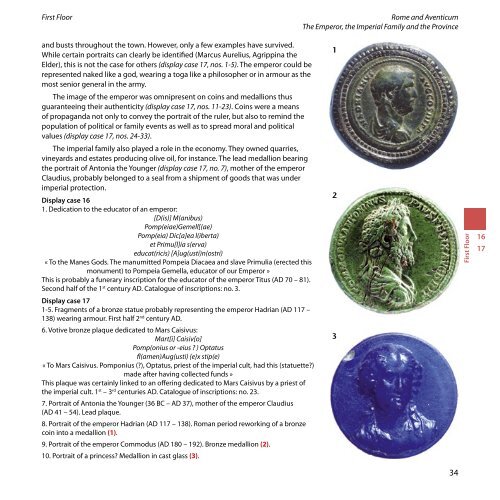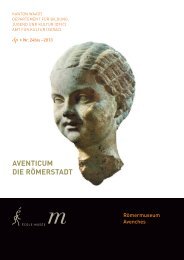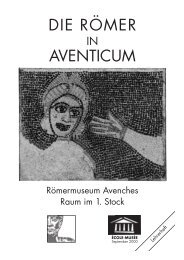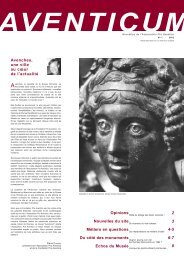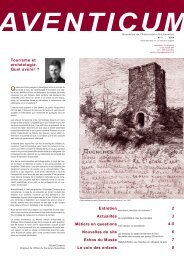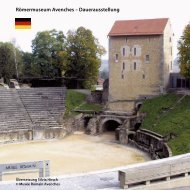Avenches – Roman Museum – Permanent Exhibition
Avenches – Roman Museum – Permanent Exhibition
Avenches – Roman Museum – Permanent Exhibition
Create successful ePaper yourself
Turn your PDF publications into a flip-book with our unique Google optimized e-Paper software.
First Floor Rome and Aventicum<br />
The Emperor, the Imperial Family and the Province<br />
and busts throughout the town. However, only a few examples have survived.<br />
While certain portraits can clearly be identified (Marcus Aurelius, Agrippina the<br />
Elder), this is not the case for others (display case 17, nos. 1-5). The emperor could be<br />
represented naked like a god, wearing a toga like a philosopher or in armour as the<br />
most senior general in the army.<br />
The image of the emperor was omnipresent on coins and medallions thus<br />
guaranteeing their authenticity (display case 17, nos. 11-23). Coins were a means<br />
of propaganda not only to convey the portrait of the ruler, but also to remind the<br />
population of political or family events as well as to spread moral and political<br />
values (display case 17, nos. 24-33).<br />
The imperial family also played a role in the economy. They owned quarries,<br />
vineyards and estates producing olive oil, for instance. The lead medallion bearing<br />
the portrait of Antonia the Younger (display case 17, no. 7), mother of the emperor<br />
Claudius, probably belonged to a seal from a shipment of goods that was under<br />
imperial protection.<br />
Display case 16<br />
1. Dedication to the educator of an emperor:<br />
[D(is)] M(anibus)<br />
Pomp(eiae)Gemell[(ae)<br />
Pomp(eia) Dic[a]ea l(iberta)<br />
et Primu[l]ia s(erva)<br />
educat(ricis) [A]ug(usti)n(ostri)<br />
« To the Manes Gods. The manumitted Pompeia Diacaea and slave Primulia (erected this<br />
monument) to Pompeia Gemella, educator of our Emperor »<br />
This is probably a funerary inscription for the educator of the emperor Titus (AD 70 <strong>–</strong> 81).<br />
Second half of the 1st century AD. Catalogue of inscriptions: no. 3.<br />
Display case 17<br />
1-5. Fragments of a bronze statue probably representing the emperor Hadrian (AD 117 <strong>–</strong><br />
138) wearing armour. First half 2nd century AD.<br />
6. Votive bronze plaque dedicated to Mars Caisivus:<br />
Mart[i] Caisiv[o]<br />
Pomp(onius or -eius ? ) Optatus<br />
fl(amen)Aug(usti) {e}x stip(e)<br />
« To Mars Caisivus. Pomponius (?), Optatus, priest of the imperial cult, had this (statuette?)<br />
made after having collected funds »<br />
This plaque was certainly linked to an offering dedicated to Mars Caisivus by a priest of<br />
the imperial cult. 1st <strong>–</strong> 3rd centuries AD. Catalogue of inscriptions: no. 23.<br />
7. Portrait of Antonia the Younger (36 BC <strong>–</strong> AD 37), mother of the emperor Claudius<br />
(AD 41 <strong>–</strong> 54). Lead plaque.<br />
8. Portrait of the emperor Hadrian (AD 117 <strong>–</strong> 138). <strong>Roman</strong> period reworking of a bronze<br />
coin into a medallion (1).<br />
9. Portrait of the emperor Commodus (AD 180 <strong>–</strong> 192). Bronze medallion (2).<br />
10. Portrait of a princess? Medallion in cast glass (3).<br />
1<br />
2<br />
3<br />
34<br />
First Floor<br />
16<br />
17


